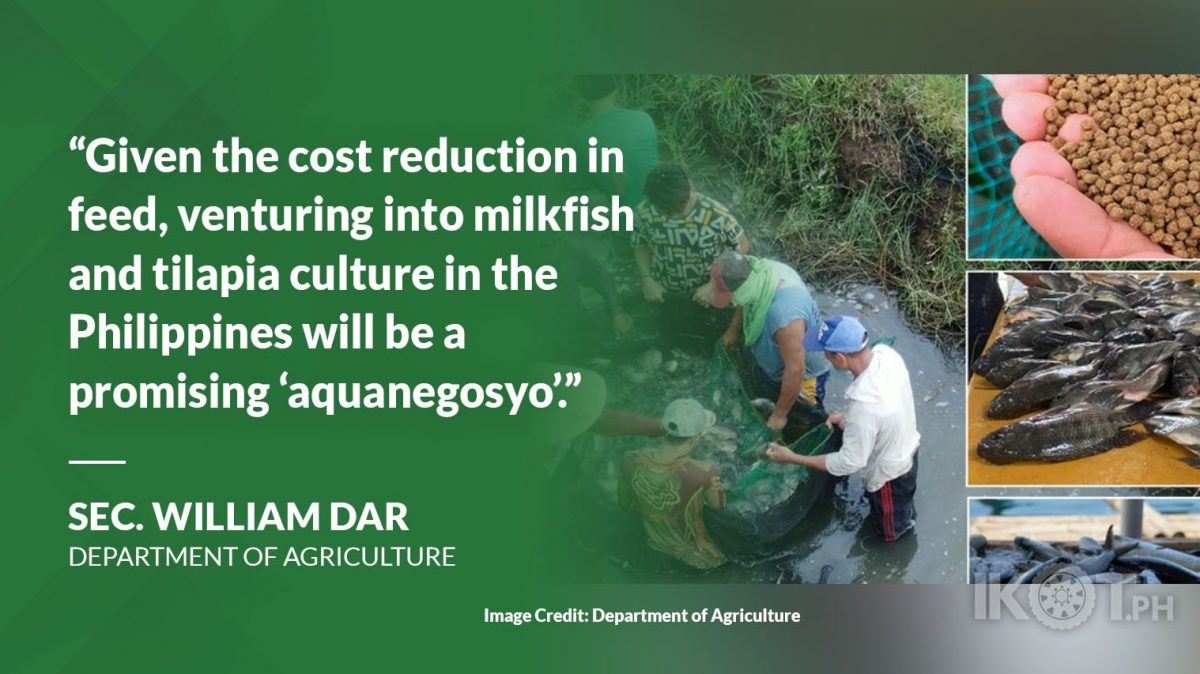To alleviate the increasing production cost of aquaculture, the Department of Agriculture (DA), through the National Fisheries Research and Development Institute (NFRDI) and the Southeast Asian Fisheries Development Center-Aquaculture Division (SEAFDEC-AQD), initiated the development of an efficient, sustainable, and low-cost feeds for milkfish and tilapia.
The new formulated feed, developed by Dr. Roger Edward Mamauag of SEAFDEC-AQD, uses by-products from corn, and poultry abattoirs and coconut-fermented copra meal to replace fish meal, which is an expensive feed ingredient as a protein source.
“The ongoing crises, COVID-19 pandemic, and Russia-Ukraine conflict, have a ripple effect in the whole seafood value chain. So it’s not just food and fuel, it also affects feed both for livestock and aquaculture since the majority of our feedstuff is being sourced outside the country,” said Agriculture Secretary William Dar.
“What we need are sustainable technologies and interventions that can provide our fishing communities locally-available ingredients.”
“What we need are sustainable technologies and interventions that can provide our fishing communities locally-available ingredients providing added benefits of cost savings and reduced imports at the same time,” Dar added.
Through the Aquafeed Research, Development, and Extension Project (ARDEP), the DA-NFRDI, partnered with SEAFDEC-AQD, and DA- Bureau of Fisheries and Aquatic Resources (BFAR) to field-test the formulated feed for milkfish and tilapia, both of which are top commodities in the Philippines.
Verification trials were conducted at NFRDI, SEAFDEC-AQD, and BFAR research stations across the country.
Results showed that the SEAFDEC-AQD fed milkfish and tilapia can compete with the commercially-fed in terms of growth performance and other biological parameters with the statistically similar results obtained from the tests.
“By making the feed cost-effective and sustainable it will increase profits and encourage more fish farmers to venture into aquaculture.”
“One of the major problems that we wanted to address through this project is to lower the cost of feeds, which comprises 50-70 percent of the production cost. By making the feed cost-effective and sustainable it will increase profits and encourage more fish farmers to venture into aquaculture,” said NFRDI Director Lilian Garcia.
Meanwhile, Dr. Maria Theresa Mutia, project leader and chief of the NFRDI’s Freshwater Fisheries Research and Development Center cited that, the SEAFDEC-AQD formulated diet consisted of sustainable, locally-available, and cheap protein sources.
SEAFDEC chief, Dan Baliao, stressed that these ingredients were used to lower the aquaculture’s dependence on fish meal given its high price and unsustainability.
Commercial fish feeds usually consist of fish meal, which is both expensive and resource-intensive since it requires harvesting fish from the oceans for feed production.
While plant-based protein sources like soybean meal and wheat gluten can provide lower-cost alternatives, the ongoing Ukraine crisis has made prices of imported feedstuff volatile and therefore unsustainable.
“That is why this aquafeed project is commendable, as we also need to look into the ecological impact of an ever-increasing demand to supply the growing aquaculture industry,” the agriculture chief stressed.
According to Mamauag, results also showed that the SEAFDEC-AQD feeds cost P27/kg for milkfish and P24/kg for tilapia, while commercial feeds cost P33-35/kg for milkfish and P32-34.00/kg for tilapia. From this price, a reduction of P6-8/kg or 18-23 percent for milkfish and P8-10/kg or 25-32 percent for tilapia in feed cost were obtained.
“Given the cost reduction in feed, venturing in milkfish and tilapia culture in the Philippines will be a promising ‘aquanegosyo’ given its higher return of investments using this locally-formulated fish feed,” the agriculture head explained.
“With this verified technology, we can now transfer this to the private sector particularly, feed milling processors for them to adopt, making the technology more accessible to fish growers and farmers,” he concluded.


